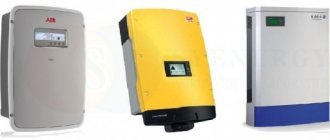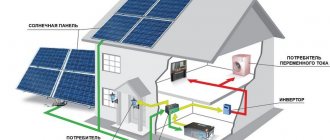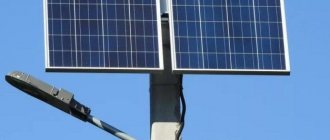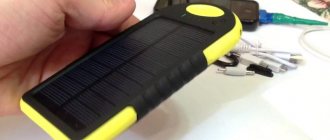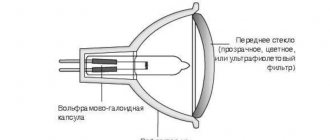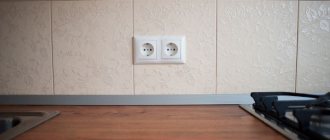Alternative energy is developing to its maximum in Europe, showing its promise with results. New types of solar panels are appearing and their efficiency is increasing.
If you want to ensure the operation of an industrial building or residential premises using solar energy, you must first learn about the differences between the equipment and understand which solar panels are suitable for the climatic conditions of a particular region.
We will help you sort out this issue. The article discusses the operating principle of photoelectric converters and provides an overview of different types of solar cells indicating their characteristics, advantages and disadvantages. After familiarizing yourself with the material, you will be able to make the right choice for arranging an effective solar system.
The principle of operation of solar panels
The vast majority of solar panels are, in the physical sense, photovoltaic converters. The electrical generating effect occurs at the site of the semiconductor pn junction.
It is silicon wafers that form the basis of the cost of solar panels, but when using them as a round-the-clock source of electricity, you will have to additionally buy expensive batteries
The panel consists of two silicon wafers with different properties. Under the influence of light, one of them develops a lack of electrons, and the other - an excess of them. Each plate has copper conductor strips that are connected to voltage converters.
An industrial solar panel consists of multiple laminated photovoltaic cells bonded together and mounted on a flexible or rigid substrate.
The efficiency of the equipment depends largely on the purity of the silicon and the orientation of its crystals. It is these parameters that engineers have been trying to improve over the past decades. The main problem with this is the high cost of the processes that underlie the purification of silicon and the arrangement of crystals in one direction throughout the panel.
Every year, the maximum efficiency of various solar panels changes upward, because billions of dollars are invested in research into new photovoltaic materials (+)
Semiconductors of photoelectric converters can be made not only from silicon, but also from other materials - the operating principle of the battery does not change.
Installation of a solar power supply system and how much it costs
Converting the sun's energy into electricity - this idea kept scientists awake for a long time. With the discovery of the properties of semiconductors, this became possible. Solar cells use silicon crystals. When sunlight hits them, a directed movement of electrons is formed in them, which is called an electric current. When connecting a sufficient number of such crystals, we obtain quite decent currents: one panel with an area of just over a meter (1.3-1.4 m2) with a sufficient level of illumination can produce up to 270 W (voltage 24 V).
Electric solar panels for the home open up many possibilities
Since the illumination changes depending on the weather and time of day, it is not possible to directly connect devices to solar panels. We need a whole system. In addition to solar panels, you need:
- Battery. During daylight hours, under the influence of sunlight, solar panels generate electric current for the home or cottage. It is not always used in full; its excess accumulates in the battery. The accumulated energy is consumed in inclement weather.
- Controller. Not a mandatory part, but desirable (if you have enough funds). Monitors the battery's charge level to prevent it from over-discharging or exceeding its maximum charge level. Both of these conditions are detrimental to the battery, so having a controller extends the life of the battery. The controller also ensures optimal operation of solar panels.
- DC to AC converter (inverter). Not all devices are designed for direct current. Many operate on alternating voltage of 220 volts. The converter makes it possible to obtain a voltage of 220-230 V.
By installing solar panels for your home or cottage, you can become completely independent from the official supplier. But for this you need to spend a decent amount:
- A kit that produces 1.5 kW per day costs about $1000. This is enough to meet the needs of a summer house or part of the electrical equipment in the house.
- A set of solar panels to produce 4 kW per day costs about $2,200.
- For 9 kW per day - $6200.
Since solar panels for home are a modular system, you can buy an installation that will provide part of the needs, gradually increasing its productivity.
Characteristics of silicon-based panels
Silicon for solar cells is made from quartz powder - ground quartz crystals. The richest deposits of raw materials are in Western Siberia and the Middle Urals, so the prospects for this area of solar energy are almost limitless.
Even now, crystalline and amorphous silicon panels already occupy more than 80% of the market. Therefore, it is worth considering them in more detail.
Monocrystalline silicon panels
Modern monocrystalline silicon wafers (mono-Si) have a uniform dark blue color over the entire surface. The purest silicon is used for their production. Monocrystalline solar cells have the highest price among all silicon wafers, but also provide the best efficiency.
Large monocrystalline solar panels with rotating mechanisms fit perfectly into desert landscapes. There are conditions for maximum productivity
The high cost of production is due to the difficulty of orienting all silicon crystals in the same direction. Due to these physical properties of the working layer, maximum efficiency is ensured only when the sun's rays are perpendicular to the surface of the plate.
Monocrystalline batteries require additional equipment that automatically rotates them during the day so that the plane of the panels is as perpendicular to the sun's rays as possible.
Layers of silicon with single-sided crystals are cut from a cylindrical block of metal, so the finished photovoltaic blocks look like a square rounded at the corners.
The advantages of monocrystalline silicon batteries include:
- High efficiency with a value of 17-25%.
- Compactness - smaller equipment area per unit of power, compared to polycrystalline silicon panels.
- Durability - sufficient efficiency of electricity generation is ensured for up to 25 years.
There are only two disadvantages to such batteries:
- High cost and long payback.
- Sensitivity to pollution . Dust scatters light, so the efficiency of solar panels coated with it sharply decreases.
Due to the need for direct sunlight, monocrystalline solar panels are installed mainly in open areas or at heights. The closer the area is to the equator and the more sunny days it has, the more preferable it is to install this particular type of photovoltaic elements.
Polycrystalline solar cells
Polycrystalline silicon panels (multi-Si) have a blue color that is uneven in intensity due to the diversified orientation of the crystals. The purity of silicon used in their production is slightly lower than that of monocrystalline analogues.
Multidirectional crystals provide high efficiency in diffused light - 12-18%. It is lower than in unidirectional crystals, but in cloudy weather conditions such panels are more effective.
The heterogeneity of the material also leads to a reduction in the cost of silicon production. The purified metal for polycrystalline solar panels is poured into molds without any special tricks.
In production, special techniques are used to form crystals, but their directionality is not controlled. After cooling, the silicon is cut into layers and processed according to a special algorithm.
Polycrystalline panels do not require constant orientation towards the sun, so the roofs of houses and industrial buildings are actively used for their placement.
During the day, with light clouds, the advantages of solar panels made of amorphous silicon will not be noticeable; their advantages are revealed only under dense clouds or in the shade (+)
The advantages of solar cells with multidirectional crystals include:
- High efficiency in diffuse light conditions.
- Possibility of permanent installation on the roofs of buildings.
- Lower cost compared to monocrystalline panels.
- Duration of operation - the drop in efficiency after 20 years of operation is only 15-20%.
Polycrystalline panels also have disadvantages:
- Reduced efficiency with a value of 12-18%.
- Relative bulkiness - more installation space is required per unit of power compared to monocrystalline analogues.
Polycrystalline solar panels are gaining an increasing market share among other silicon batteries. This is ensured by wide potential opportunities for reducing the cost of their production. The efficiency of such panels also increases every year, rapidly approaching 20% for mass-produced products.
Amorphous silicon solar panels
The mechanism for producing solar panels from amorphous silicon is fundamentally different from the production of crystalline photovoltaic cells. Here it is not a pure non-metal that is used, but its hydride, the hot vapors of which are deposited on the substrate.
As a result of this technology, classical crystals are not formed, and production costs are sharply reduced.
Deposited amorphous silicon solar cells can be mounted on either a flexible polymer substrate or a rigid glass sheet
At the moment, there are already three generations of amorphous silicon panels, each of which significantly increases efficiency. If the first photovoltaic modules had an efficiency of 4-5%, now second-generation models with an efficiency of 8-9% are widely sold on the market.
The latest amorphous panels have an efficiency of up to 12% and are already starting to appear on sale, but they are still quite expensive.
Due to the features of this production technology, it is possible to create a layer of silicon on both a rigid and flexible substrate. Because of this, amorphous silicon modules are actively used in flexible thin-film solar modules. But options with an elastic backing are much more expensive.
The physicochemical structure of amorphous silicon allows maximum absorption of photons of weak scattered light to generate electricity. Therefore, such panels are convenient for use in northern regions with large free areas.
The efficiency of batteries based on amorphous silicon does not decrease even at high temperatures, although they are inferior in this parameter to gallium arsenide panels.
At the same equipment cost, silicon hydride solar panels show greater performance than their mono- and polycrystalline counterparts (+)
To summarize, we can point out the following advantages of amorphous solar panels:
- Versatility - the ability to manufacture flexible and thin panels, mounting batteries on any architectural form.
- High efficiency in diffused light.
- Stable operation at high temperatures.
- Simplicity and reliability of design . Such panels practically do not break.
- Maintains performance in difficult conditions - less drop in performance when the surface is dusty than with crystalline analogues
The service life of such photovoltaic cells, starting from the second generation, is 20-25 years with a power drop of 15-20%. The only disadvantages of amorphous silicon panels include the need for larger areas to accommodate equipment of the required power.
Efficiency
The efficiency of solar cells is determined largely by the purification stage of the silicon used in production and the orientation of the crystals in it. These characteristics are what developers strive to improve. Every year, the efficiency value can be increased (in different types by different amounts), thanks to billions of dollars of investment in the research of photovoltaic cells. However, the efficiency remains insufficient for widespread use of solar panels.
Overview of silicon-free devices
Some solar panels, made using rare and expensive metals, have an efficiency of more than 30%. They are several times more expensive than their silicon counterparts, but still occupy a high-tech trading niche due to their special characteristics.
Rare metal solar panels
There are several types of rare metal solar panels, and not all of them are more efficient than monocrystalline silicon modules.
However, the ability to operate in extreme conditions allows manufacturers of such solar panels to produce competitive products and conduct further research.
Cadmium telluride panels are actively used for cladding buildings in equatorial and Arabian countries, where their surface heats up to 70-80 degrees during the day
The main alloys used to make photovoltaic cells are cadmium telluride (CdTe), indium copper gallium selenide (CIGS) and copper indium selenide (CIS).
Cadmium is a toxic metal, and indium, gallium and tellurium are quite rare and expensive, so mass production of solar panels based on them is even theoretically impossible.
The efficiency of such panels is at the level of 25-35%, although in exceptional cases it can reach up to 40%. Previously, they were used mainly in the space industry, but now a new promising direction has emerged.
Due to the stable operation of photocells made of rare metals at temperatures of 130-150°C, they are used in solar thermal power plants. In this case, the sun's rays from tens or hundreds of mirrors are concentrated on a small panel, which simultaneously generates electricity and ensures the transfer of thermal energy to a water heat exchanger.
As a result of heating the water, steam is formed, which causes the turbine to rotate and generate electricity. In this way, solar energy is converted into electrical energy simultaneously in two ways with maximum efficiency.
Polymer and organic analogues
Photovoltaic modules based on organic and polymer compounds began to be developed only in the last decade, but researchers have already made significant progress. The greatest progress is demonstrated by the European company Heliatek , which has already equipped several high-rise buildings with organic solar panels.
HeliaFilm- type roll film structure is only 1 mm.
In the production of polymer panels, substances such as carbon fullerenes, copper phthalocyanine, polyphenylene and others are used. The efficiency of such photovoltaic cells already reaches 14-15%, and the production cost is several times less than crystalline solar panels.
The issue of degradation time of the organic working layer is acute. So far, it is not possible to reliably confirm the level of its efficiency after several years of operation.
The advantages of organic solar panels are:
- possibility of environmentally safe disposal;
- low cost of production;
- flexible design.
The disadvantages of such photovoltaic cells include relatively low efficiency and the lack of reliable information about the periods of stable operation of the panels. It is possible that in 5-10 years all the disadvantages of organic solar cells will disappear, and they will become serious competitors for silicon wafers.
History of development
Solar batteries began their development back in the 19th century. The prerequisite for this was revolutionary research on the transformation of solar energy into a more material component.
The first solar panels had an efficiency of only 1%, and their chemical basis was selenium. The first contributions to the development of such batteries were made by A. Becquerel, W. Smith, and C. Fritts.
But using only 1% of the total energy supplied to the solar panel is very little. These elements could not provide uninterrupted power supply to the equipment, so research continued.
In 1954, three scientists - Gordon Pearson, Darryl Chapin and Cal Fuller - invented a battery with an efficiency of 4%. It worked on silicon, and subsequently its efficiency was increased to 20%.
Currently, solar panels produce only 1% of the world's energy. They are mainly carried out to places that are difficult to reach for electrification. This power source is widely used in the space industry. Experts believe that all paths are open to such a battery, since solar activity is increasing every year.
In our latitudes, these batteries are installed in private homes to save energy consumption and care for the environment.
Average prices
The cost of solar panels is one of the criteria for their selection.
The retail price for the models discussed above, produced by Chinese and sold through specialized organizations, is:
- Solar battery 60P – 3400.00 rubles;
- Solar battery 100P – 4980.00 rubles;
- Solar battery TopRaySolar TPS-FLEX-50W (50.0 W) – 6790.00 rubles;
- Solar battery TopRaySolar TPS-FLEX-80W (80.0 W) – 10,410.00 rubles;
- Solar battery TopRaySolar TPS-FLEX-100W (100.0 W) – 12,440.00 rubles;
- Solar battery TopRaySolar 100M (100.0 W) – 5210.00 rubles;
- Solar battery TopRaySolar TPS-FLEX-100W (100.0 W) – 12,440.00 rubles.
The cost of devices from other manufacturers with similar technical parameters lies in the same price range, so there is always the opportunity to make your own choice, in accordance with individual wishes.
